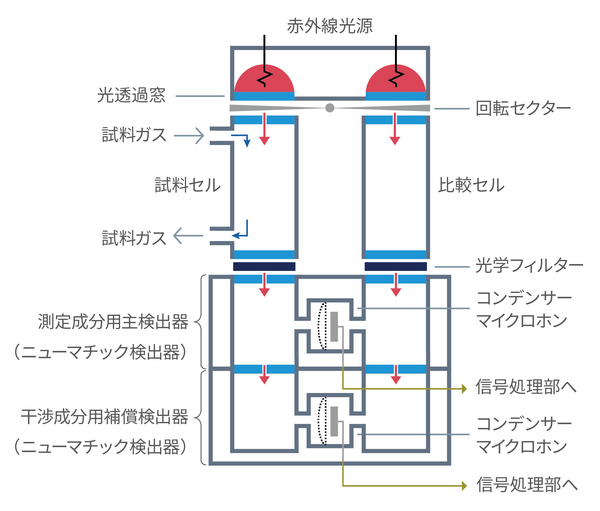
圖6顯示了實際紅外線氣體分析儀結構的範例。它由主要部件組合而成,功能如表1所示。

圖6:紅外線氣體分析儀結構
主要部件及功能(表1)
| 1) Infrared light source | Emits infrared radiation light containing wavelengths of 2.5-25μm in mid-infrared radiation |
| 2) Chopper | Intermittent infrared radiation supplied from infrared lights source to a sample cell and a reference cell at a regular cycle (A type of modulation mechanism) |
| 3) Sample cell, Reference cell | The sample cell is a gas cell that flows sample gas containing the measured component gas. The reference cell is a gas cell that flows reference gas or is enclosed, and it becomes an optical path for infrared radiation. |
| 4) Optical filter | A Multi-layered membrane filter that transmits only infrared radiation of the absorbed specific wavelength of the measured component gas |
| 5) Main detector for the measurement component | Detection mechanism including sensors to detect changes of the infrared absorption of the measured component |
| 6) Compensation detector for the interference component | Detection mechanism, including sensors, to detect changes of the infrared absorption of interfering component to compensate the influence of interfering component for the measured component |
| 7) Signal processing | Signal processing for the detected singnals of 5 and 6 to calculate the concentration of the measured component |
写真1:赤外線ガス分析計の主要部品と構成例
圖1所示為紅外線氣體分析儀主要部件配置範例。為了快速回應各種市場需求,HORIBA 自行生產紅外線氣體分析儀的關鍵零件:紅外線光源、樣品池、參考池、濾光片和偵測器。
本節介紹實際紅外線氣體分析儀的工作原理。紅外線氣體分析儀的基本結構(圖4)由參考池、斬波器和氣動偵測器(圖5)組成,可利用表2(圖6、圖1)中的三個主要功能測量氣體濃度。
| 1) Detection Function of the Measured Component | Detects infrared radiation absorbed corresponding to measured component in sample gas |
| 2) Modulation Function | To improve the measurement accuracy, the infrared radiation from the infrared light source is intermittented at a regular interval, and the detector signal is output as a modulated signal. |
| 3) Compensation Function for Interfering Component | Detect infrared absorption corresponding to the concentration of the interfering component in order to compensate for interfering component effects on the measured component |
本節介紹樣品氣體為廢氣並測量樣品氣體中的 CO 的情況下的工作原理。
在氣動偵測器內部(圖 5),待測成分氣體 CO 包含在由電容式麥克風隔膜隔開的兩個腔室中。檢測器中的電容式麥克風的隔膜由於兩個腔室之間的壓力差而移動,改變由該隔膜和固定板形成的電容器的電容,並且壓力差被檢測為電信號。
參考池中封有不吸收紅外線輻射的惰性氣體,例如 N2。在該池中,紅外線輻射不被吸收,只有 CO 吸收波長的紅外線輻射透過濾光片並進入參考池下方偵測器的右室。封閉的二氧化碳吸收透射的紅外線輻射並產生熱量,從而增加腔室壓力並以恆定壓力不斷推動隔膜。
另一方面,紅外線輻射在樣品池中被吸收,取決於廢氣中的 CO 濃度。特定波長的紅外線輻射被樣品池吸收後,被CO紅外線吸收波長的濾光片選擇性地透過,進入樣品池下方檢測器的左室,以對應的壓力推動隔膜左室中封閉的二氧化碳吸收的紅外線輻射量。此時,膜片因左右腔的壓力差而移動(不移動或向左腔移動。至於壓力,左腔≤右腔)。此壓力差作為廢氣中CO的紅外線吸收被轉換並輸出為電訊號,由訊號處理單元轉換為CO氣體濃度值。
圖 8:操作與紅外線電源
具體來說,它是一種在紅外線光源下旋轉像領結一樣的薄板(稱為斬波器)的機構,執行調製操作(圖8)。
透過旋轉此薄板,樣品池和參考池的每個紅外線光源的紅外線輻射量從0%到100%週期性地連續變化。例如,如果斬波器與兩個單元的紅外線光源完全重疊(旋轉角度:0度),則兩個單元中都不會產生紅外線輻射,且電容式麥克風膜片不會膨脹。相反,當沒有重疊時(旋轉角度:90度),來自紅外線光源的100%紅外線輻射被提供給兩個單元。
圖9:紅外線氣體分析儀的操作和成分濃度訊號的檢測
透過結合 1) 和 2),電容式麥克風可以偵測與流向樣品池的被測成分(廢氣中的 CO)濃度成比例的側壓差(圖 9)。
Figure 10: Compensation detector for the interfering component and obtaining the measured component signal after correction for interference effect
干擾成分的補償偵測器的放置使得與被測成分的主偵測器具有相同的紅外線輻射光路和調製功能(圖10)。用於干擾補償的偵測器也是與被測部件的主偵測器相同類型的氣動偵測器(圖 5)。被測分量主偵測器中被測分量和乾擾分量吸收的剩餘紅外線輻射傳送到干擾分量補償偵測器。這種發射的紅外線輻射被封裝在干擾元件補償檢測器中的干擾校正氣體吸收,並被電容式麥克風檢測為壓力差。這會偵測到與干擾成分濃度相對應的校正訊號 (B)(圖 10 幹擾成分校正訊號圖)。在訊號處理中,將主偵測器針對被測成分的輸出訊號(A)減去干擾成分補償偵測器的輸出訊號(B),即可得到干擾校正後的被測成分的濃度。
內容摘要
Click here for a list of measurement principle explanations of continuous gas analyzers >
如您有任何疑問,请在此留下詳細需求或問題,我們將竭誠您服務。



